Hanfu

Die chinesische Han-Kleidung oder Hanfu (chinesisch 漢服 / 汉服, Pinyin Hànfú, Jyutping Hon4fuk6 – „Kleidung der Han“, Min Nan Hanhok), auch Hànzhuāng (漢裝 / 汉装), oder Huáfú (華服 / 华服) genannt und manchmal schlicht als chinesische Seiden-Robe[1][2].
Begriff
Die Bezeichnung Hanfu wurde ursprünglich nicht von den Han-Chinesen gebraucht, sondern von den nationalen Minderheiten, um ihre Kleidung von der der Chinesen zu unterscheiden. Es setzt sich zusammen aus dem Zeichen hàn漢 / 汉, chinesisch für „Han-Chinese“ bzw. „Han-Volk“ und fú服, chinesisch für „Kleidung“.
Geschichte

Der Hanfu war die historische Kleidung der Han-Chinesen während eines großen Teils der chinesischen Geschichte und wurde insbesondere in den Jahrhunderten vor der Eroberung durch die Mandschus und der Errichtung der Qing-Dynastie (1644) getragen. Während der Qing-Dynastie durfte die große Mehrheit der Han-Männer sich weiterhin kleiden, wie sie es während der Ming-Dynastie getan hatte.[3][4]
- Eine Han-Frau (Qing-Dynastie)
- Ein Han-Kind (Qing-Dynastie)
- Kleidung eines taoistischen Priesters (Qing-Dynastie)
Galerie
- Tsa-chü-ch'ui-shao-fu, Nördliche Wei-Dynastie (5. Jh. n. Chr.)
- Porträt von Herzog Yi von Wey im Hanfu von Ku K'ai-chih
- Junge Leute in Hanfu, 2007
- Junge Leute in Hanfu, 2009
- Mann in Hanfu (Daopao, daoistische Robe), 2009
- Mann in Hanfu (Shenyi, tiefes Gewand)
Weblinks
- Der Andere Trend (Asienspiegel)
- Hanfu-Wiederbelebungsbewegung
Einzelnachweise
- ↑ Gernet, Jacques (1962). Daily Life in China on the Eve of the Mongol Invasion, 1250-1276. Translated by H. M. Wright. Stanford: Stanford University Press. p. 130. ISBN 0-8047-0720-0.
- ↑ Kevin Carrico, A State of Warring Styles
- ↑ Twitchett, Denis; Fairbank, John K. (2008) Cambridge History of China Volume 9 Part 1 The Ch'ing Empire to 1800, p87-88: "History The term "hanfu" means "dress of the Han people."... '(during Qing dynasty) Han resistance was so severe that the policies were modified. Men, government officials, Confucian scholars, and prostitutes wore the Manchu style; women, errand boys, children, monks, and Taoists were free to wear Han styles. '"
- ↑ Edward J. M. Rhoads: Manchus and Han: Ethnic Relations and Political Power in Late Qing and Early Republican China, 1861–1928. University of Washington Press, 2000, ISBN 978-0-295-98040-9, S. 60– (google.com): "However, the dress code was required only of the scholar-official elite and not of the entire male population. Therefore, the great majority of Han men were free to continue to dress as they had during the Ming."
Auf dieser Seite verwendete Medien
Duque Yi de Wey de Mujeres Sabias y Benevolentes por Ku K'ai-chih. Copia de la dinastía Sung (960-1279) según la obra original del siglo Ⅳ. Ciudad Prohibida, Pequín.
Close-up detail of the Chinese painting Night Revels, handscroll, ink and colors on silk, 28.7 x 335.5 cm.
Autor/Urheber: Supersentai, Lizenz: CC BY-SA 3.0
Daopao (道袍) - Men's Chinese traditional clothing (hanfu)
In recent years, young Chinese are trying to revive traditional en:Han Chinese clothing (汉服运动) using internet-based forums. A few Han Chinese clothing gatherings both within China and overseas were organized. Han clothing was lost for 267 years as a result of the Manchu subjugation of China, which lasted from 1644 to 1911.
清俗紀聞-清代婦女1
Panling Lanshan (盘领襕衫), Zhiduo (直裰) and Shenyi (深衣) - Men's Chinese traditional clothing (hanfu)
康熙帝南巡图卷,治黃河
清俗紀聞-清代道士
清俗紀聞
北魏前期 列女古賢圖局部梳十字髻穿雜裾的女子
Autor/Urheber: Supersentai, Lizenz: CC BY-SA 3.0
Shenyi (深衣) - Men's Chinese traditional clothing (hanfu)

























